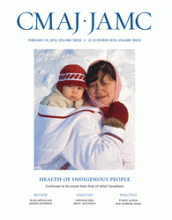Abstract
Background: Food security (i.e., a condition in which all people, at all times, have physical and economic access to sufficient, safe and nutritious food to meet their dietary needs and food preferences for an active and healthy life) has been noted to be lower in indigenous communities in Canada. We investigated the prevalence of inadequate food security, or food insecurity, among Inuit households with preschool children.
Methods: We conducted a cross-sectional survey of the health status of 388 randomly selected Inuit children aged three to five years in 16 Nunavut communities during the period from 2007 to 2008. From the survey data, we classified levels of food insecurity specifically among children. We also classified levels of overall food insecurity of the household of each child. We calculated the weighted prevalence of levels of child food insecurity and of household food insecurity.
Results: Nearly 70% of Inuit preschoolers resided in households rated as food insecure (69.6%; 95% confidence interval [CI] 64.7%–74.6%). Overall, 31.0% of children were moderately food insecure, and 25.1% were severely food insecure, with a weighted prevalence of child food insecurity of 56.1% (95% CI 51.0%–61.3%). Primary care-givers in households in which children were severely food insecure reported experiencing times in the past year when their children skipped meals (75.8%), went hungry (90.4%) or did not eat for a whole day (60.1%). Primary caregivers in households in which children were moderately food insecure reported experiencing times in the past year when they worried food would run out (85.1%), when they fed their children less expensive food (95.1%) and when their children did not eat enough because there was no money for food (64.3%).
Interpretation: We observed a high prevalence of household food insecurity, with a substantial proportion of children with severely food insecure status. Interventions are needed to ensure a healthy start in life for Inuit preschoolers.











